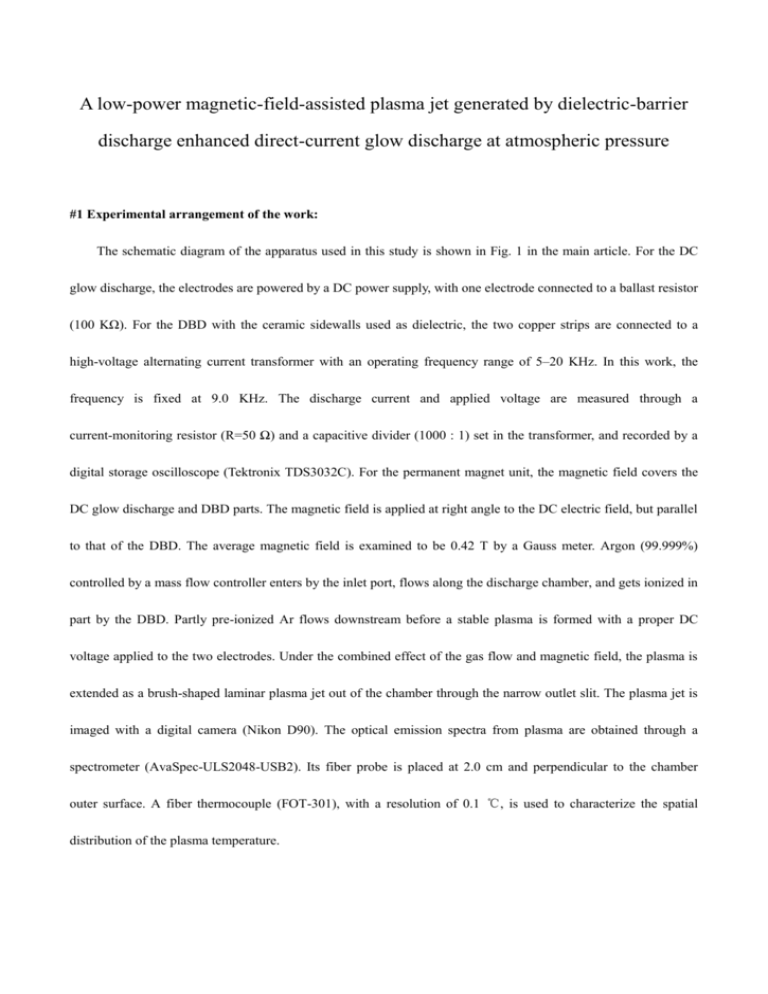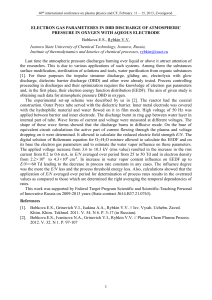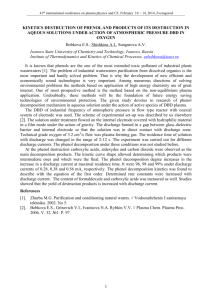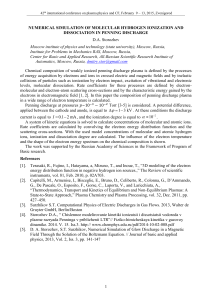Supplementary material for A low-power magnetic
advertisement

A low-power magnetic-field-assisted plasma jet generated by dielectric-barrier discharge enhanced direct-current glow discharge at atmospheric pressure #1 Experimental arrangement of the work: The schematic diagram of the apparatus used in this study is shown in Fig. 1 in the main article. For the DC glow discharge, the electrodes are powered by a DC power supply, with one electrode connected to a ballast resistor (100 KΩ). For the DBD with the ceramic sidewalls used as dielectric, the two copper strips are connected to a high-voltage alternating current transformer with an operating frequency range of 5–20 KHz. In this work, the frequency is fixed at 9.0 KHz. The discharge current and applied voltage are measured through a current-monitoring resistor (R=50 Ω) and a capacitive divider (1000 : 1) set in the transformer, and recorded by a digital storage oscilloscope (Tektronix TDS3032C). For the permanent magnet unit, the magnetic field covers the DC glow discharge and DBD parts. The magnetic field is applied at right angle to the DC electric field, but parallel to that of the DBD. The average magnetic field is examined to be 0.42 T by a Gauss meter. Argon (99.999%) controlled by a mass flow controller enters by the inlet port, flows along the discharge chamber, and gets ionized in part by the DBD. Partly pre-ionized Ar flows downstream before a stable plasma is formed with a proper DC voltage applied to the two electrodes. Under the combined effect of the gas flow and magnetic field, the plasma is extended as a brush-shaped laminar plasma jet out of the chamber through the narrow outlet slit. The plasma jet is imaged with a digital camera (Nikon D90). The optical emission spectra from plasma are obtained through a spectrometer (AvaSpec-ULS2048-USB2). Its fiber probe is placed at 2.0 cm and perpendicular to the chamber outer surface. A fiber thermocouple (FOT-301), with a resolution of 0.1 ℃, is used to characterize the spatial distribution of the plasma temperature. #2 Calculation of the electric power dissipated in the dielectric-barrier discharge (DBD) cell: The electric power dissipated in the DBD cell, determined according to the Manley’s theory,1 is expressed as: P DBD 4fC d u dis(u peak Cd C g u dis ). Cd It relates PDBD to the operating frequency f , the peak voltage u peak , the average discharge voltage udis across the gas gap, and the capacitances of dielectrics ( C d ) and discharge gap ( C g ). Figure 2(b) in the main article shows that the microdischarges stop before the peak voltage in the former positive half cycle and do not occur until the applied voltage approaches about -0.75 KV in the latter negative half cycle. The threshold voltage uth is -0.75 KV and related to the average discharge voltage by uth u peak 2(C d C g )C d1udis .1 With f 9 KHz , C g 0.4 pF , and C d 0.82 pF , the electric power is estimated to be about 12 mW. 1 U. Kogelschatz, Plasma Chem. Plasma Proc. 23, 1(2003). #3 Explanation for the difference of the effect of magnetic field on the V–I curve in Zone Ⅰ and Ⅱ: Figure 3 in the main article shows that the effect of magnetic field on the V–I curve is different in the two zones. In Zone Ⅰ, a higher discharge voltage is required to maintain a discharge with the same discharge current, with the magnetic field applied. This is attributed to the fact that insufficient new electrons are produced in the curved and lengthened electron path due to few electrons in the low discharge current region though the ionization is enhanced, and many electrons are brought out of the discharge chamber by the Lorentz force. However, the application of magnetic field allows the discharge voltage to be lessened in Zone Ⅱ. This is because that there exist many electrons in the high discharge current region and abundant new electrons are generated in the curved and lengthened electron path though parts of electrons flee out of the discharge chamber. Around 10 mA, the application of magnetic field makes the discharge voltage almost unchanged. This means that the new electrons generated in the curved and lengthened electron path compensate for the ones that are brought out of the discharge chamber. #4 Calculation of the electron density in the plasma: The electron density ne in the plasma can be estimated from the electronic parameters of the discharge:1 the electron charge e , the electric field E , the current density j , and the electron mobility e ne j /( Eee) . The current density is the current divided by the cross section of discharge ( j I / S ). Assuming that the cross section of discharge is approximately the same as that of the electrodes, the current density j is 1.6 A/cm 2 , with I 10 mA and S 6.4 10 3 cm 2 . The electric field E is considered as the voltage Vdis between the two electrodes divided by the gas gap,2 and it is estimated to be e 4.3 10 2 cm 2 /(V s),1 the electron density is about 1.3 1014 cm 3 . 1 Y. P. Raizer, Gas Discharge Physics, 2nd ed. (Springer, Berlin, Germany, 1991). 2 R. H. Stark and K. H. Schoenbach, Appl. Phys. Lett. 74, 3770 (1999). 0.18 KV/cm . With






